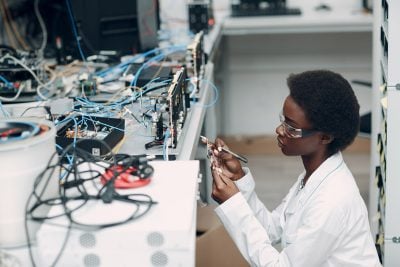Next week world leaders meet in Nairobi for the inaugural Africa Climate Summit and UNFCCC Africa Climate Week, to agree on a new vision for climate-positive growth. Green hydrogen – which can provide a route to energy access for all in Africa, and decarbonise pivotal parts of the global economic system, like heavy industry, shipping and aviation – is key to this vision. If Africa can maximise its role in the rising hydrogen economy, the continent would simultaneously respond to the socio-economic needs of its countries; addressing energy poverty and driving development.
Africa’s world-class wind, solar and hydro power resources are central to facilitating the just energy transition; providing millions of Africans with access to clean energy and promoting sustainable development and poverty eradication. These renewable resources can also be used to power electrolysers for green hydrogen production.
We must act with absolute urgency to realise this potential – by fully integrating green hydrogen within the roadmaps for African countries’ energy transitions, industrial plans and climate commitments.
Hydrogen is critical for three reasons:
Firstly, we must all do what we can to avoid climate breakdown. This can only be achieved by replacing oil, gas and coal with renewable alternatives. Africa’s rich renewable resources can power our own sustainable development, as well as meeting the world’s need for clean fuels.
Secondly, Africa can secure over 4m jobs by ensuring green hydrogen production and processing takes place in Africa. A ready supply of green hydrogen is a key piece of the decarbonisation puzzle for many sectors, from the steel and petrochemical industries, to mobility and agriculture. Transforming Africa into one of the world’s leading hubs for green hydrogen production would therefore significantly elevate Africa’s role in global green manufacturing supply chains.
Green hydrogen can be a major driver of Africa’s blueprint to become a global powerhouse of the future, as espoused in Agenda 2063. This is a moment to move Africa up the value chain; as an exporter of goods, not raw materials.
Production of green hydrogen for domestic consumption and export in Egypt, Morocco, Mauritania, Kenya, Namibia and South Africa (the member countries of the Africa Green Hydrogen Alliance), alone could create up to 4.2m new jobs and raise their GDP by $66-126bn by 2050, equivalent to 6-12% of their current GDP.
Kenya, the host of this week’s summit, has ambitious plans for green hydrogen and its derivatives such as green ammonia and green fertiliser, and is releasing its national green hydrogen roadmap during the summit. Moving into green fertiliser production is a strategic play that would shield Kenya from volatile prices and uncertain supplies of ‘grey’ fertiliser, produced from fossil fuels and imported from abroad. It will help fuel and decarbonise the country’s expanding agricultural sector and contribute to food security, which has been hit hard by droughts.
Realising Africa’s green hydrogen potential is however not inevitable. Africa has over 70 announced green hydrogen projects – and the list is growing – but they all need finance to get off the ground. Making finance and cost competitive capital available for these transformative projects is crucial, particularly in light of massive green hydrogen incentives, such as the US Inflation Reduction Act and EU Net Zero Industry Act, which are attracting investments to these countries and regions.
Africa’s hydrogen projects require a cumulative investment of $900bn by 2050; translating to about $6bn annually between now and 2030, with bigger leaps in investment needed in following decades. Mauritania alone is planning to host four large scale green hydrogen projects costing approximately $100bn. The investment numbers are eye-watering, until you compare them with the $one trillion that the world spent on fossil fuel subsidies in 2022, according to the International Energy Agency.
Mobilising this capital requires a massive effort by public and private finance institutions – we need to think out of the box to come up with innovative financing solutions. Public and private funding programs are needed to bring down the production costs of green hydrogen in Africa and encourage its uptake in hard-to-abate industrial and transportation sectors.
Africa needs access to low cost capital to fully industrialise and lift our people from poverty. Currently, the cost of capital can be up to five times higher than in OECD countries due to perceived investment risk. Creating good investment conditions with progressive policy measures, that incentivise domestic renewable energy and green hydrogen industries, is key to unlocking public and private investment in Africa’s green hydrogen sector.
This is not about hand-outs – only finance costs similar to those in developed countries. Development finance and commercial banks need to include green hydrogen in their green financing and investing taxonomies (e.g. for green bonds), and to develop incentives for green hydrogen projects, such as differentiated loan interest rates. Innovative financing examples are emerging – and they need to be rapidly scaled to drive confidence. Namibia has launched the €1bn “SDG Namibia One Fund” focused on green hydrogen. In June, an innovative $1bn “SA-H2” blended finance fund was announced to support South Africa’s green hydrogen projects.
Outside Africa demand is building. Europe has an ambitious target to produce 10m tonnes of green hydrogen by 2030, and is putting in place schemes to import green hydrogen. The European Hydrogen Bank and Germany’s “H2Global” support scheme recently joined forces to procure green hydrogen from outside the EU, using public money to bridge the cost gap between supply and demand. There is a high chance that Africa will benefit from the scheme.
The innovative “1% for 1.5 degrees” finance model for multilateral development banks like the African Development Bank is another much needed climate finance instrument. It would allow countries to borrow at a 1% interest rate, with a 10-year grace period during which repayments would be delayed – followed by a 20-year repayment phase.
The Nouakchott Message, announced at the Africa Green Hydrogen Finance Accelerator meeting in Mauritania in April (falling within the wider Bridgetown Initiative), sets out clear recommendations to make blended financing work for the African green hydrogen economy. We also need to mobilise to implement the “Africa Just and Affordable Energy Initiative”, which aims to provide technical and policy support to make equitable, financially viable energy transitions a reality in all African countries; securing access to affordable energy by 2027 for at least 300m Africans.
In Nairobi week we need to accelerate momentum. We call on public and private finance institutions to invest $6bn each year between now and 2030 into renewable energy and green hydrogen projects – and to announce firm financing decisions by COP28 in Dubai from the end of November.
Finance is a vital bridge to Africa’s future. A future which must be cleaner, greener, and more prosperous for all its citizens.
Want to continue reading? Subscribe today.
You've read all your free articles for this month! Subscribe now to enjoy full access to our content.
Digital Monthly
£8.00 / month
Receive full unlimited access to our articles, opinions, podcasts and more.
Digital Yearly
£70.00 / year
Our best value offer - save £26 and gain access to all of our digital content for an entire year!


 Sign in with Google
Sign in with Google 



